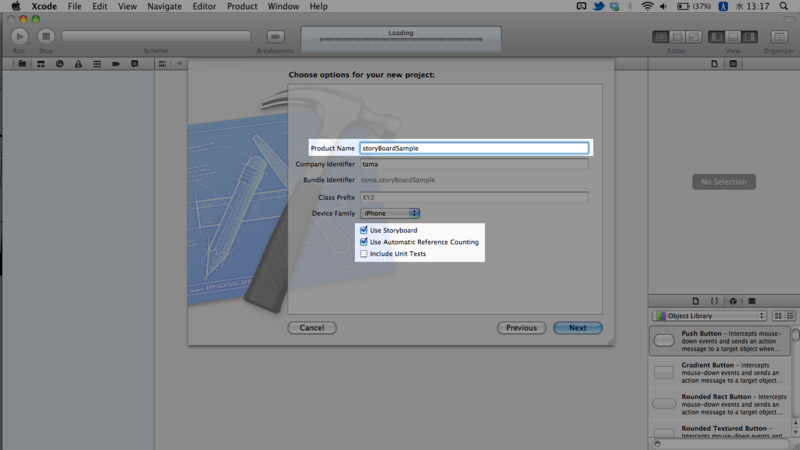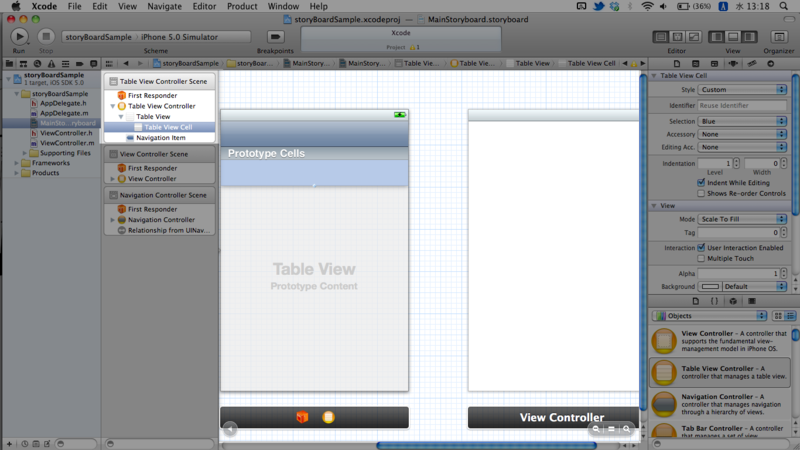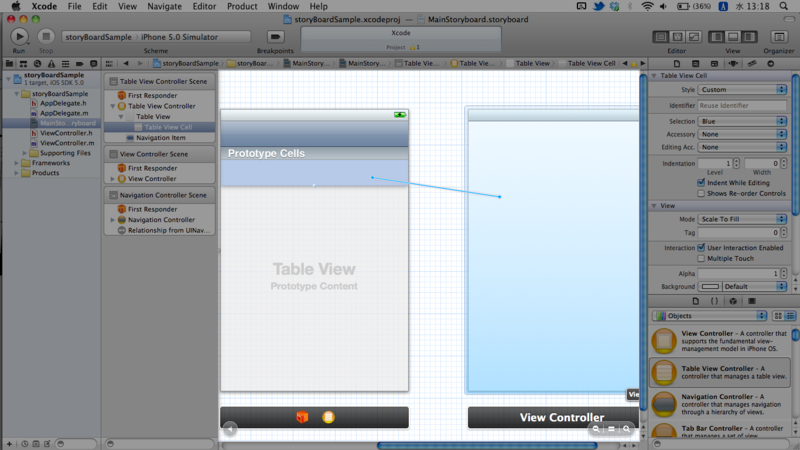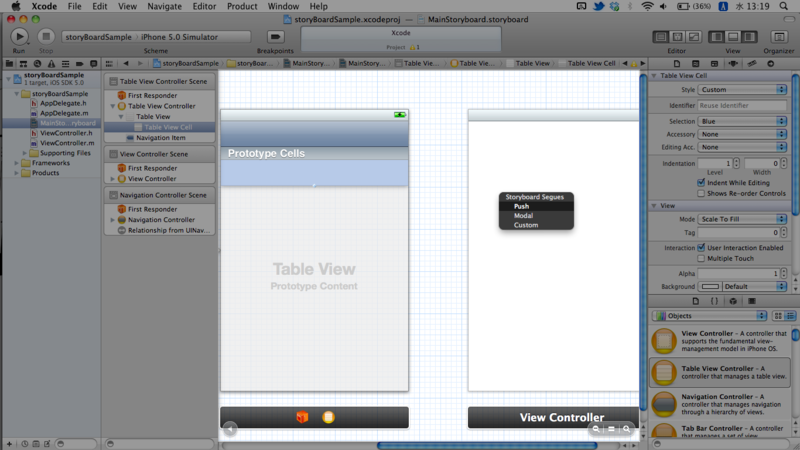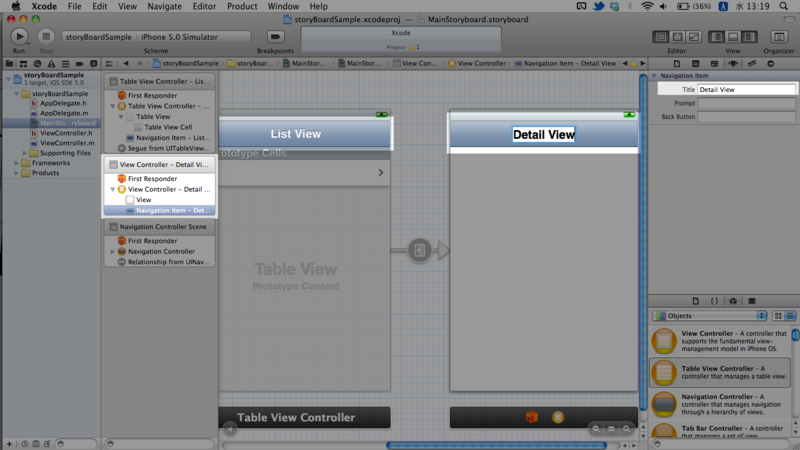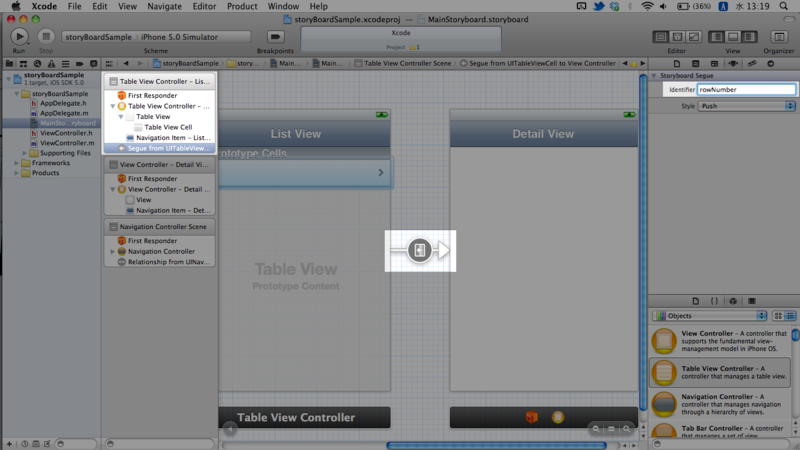StoryBoardを使って、NavigationController+TableViewControllerでサンプルアプリをつくります。
- つくるもの
ナビゲーションバーつきのTableViewController
セルは動的に生成、クリックするとViewControllerに遷移
- 手順
-
- プロジェクトの作成
Single View Applicationを選択。
今回Product Name(プロジェクトの名前)は「sotryBoardSample」にしました。
下部の"Use StoryBoard"と"Use Automatic Reference Counting"にチェック。
Nextを押し保存して、プロジェクトを作成します。
-
- TableViewControllerの配置
右ペインが出ていなければ開き、右下からTable View ControllerをすでにあるViewControllerの左へドラッグしてきます。
ぽい。
右ペインの"Is Initial View Controller"にチェックを入れます。
アプリを起動すると、このTableViewControllerが先に表示されるようになります。
-
- NavigationControllerの挿入
フォーカスはTableViewControllerに合わせたまま、上部メニューの"Editor"から"Embed In"→"Navigation Controller"を選択。
TableViewControllerの更に左側に、NavigationControllerが挿入されました。
-
- TableViewController→ViewControllerへ紐付け
中央ペインのセル部分をクリック。
control+ドラッグして、右のViewControllerではなす。
ビューの遷移方法を聞かれるので、pushを選択。
じゃん。segueができました。
ちゃんとナビゲーションバーも出てきます。
わかりやすいように、ナビゲーションバーにタイトルをつけます。
バー中央をダブルクリックするか、右ペインのTitleにそれぞれ"List View" "Detail View"と入力。
先ほど作成したsegueをクリックし、右ペインのIdentifierに"rowNumber"と入力。
デバッグ用に、ViewControllerにLabelを置いておきます。
ここでは"row number"と変えてありますが、そのままでも大丈夫です。
-
- TableViewControllerのクラスを作成
左ペインのStoryBoardSampleフォルダを右クリックして、New File...を選択。
UIViewController subClassを選び、
クラス名を"ListViewController"に。
ドロップダウンからUITableViewControllerを選択、下ふたつのチェックは外して、作成。
-
- storyboardと紐付け
いったんstoryboardに戻り、TableViewControllerを選択。
右ペインの「Identity Inspector」で、ListViewControllerクラスを紐付け。
-
- コードの書き換え
まず、ListViewController.mから。
生成するセクションとセルの個数を変更します。
- (NSInteger)numberOfSectionsInTableView:(UITableView *)tableView { #warning Potentially incomplete method implementation. // Return the number of sections. return 0; } - (NSInteger)tableView:(UITableView *)tableView numberOfRowsInSection:(NSInteger)section { #warning Incomplete method implementation. // Return the number of rows in the section. return 0; }
この戻り値を、1セクション、3セルに変更。
#warning〜も取ってしまいます。
- (NSInteger)numberOfSectionsInTableView:(UITableView *)tableView { // Return the number of sections. return 1; } - (NSInteger)tableView:(UITableView *)tableView numberOfRowsInSection:(NSInteger)section { // Return the number of rows in the section. return 3; }
セル内には、何番目かを表示させるようにします。
- (UITableViewCell *)tableView:(UITableView *)tableView cellForRowAtIndexPath:(NSIndexPath *)indexPath { static NSString *CellIdentifier = @"Cell"; UITableViewCell *cell = [tableView dequeueReusableCellWithIdentifier:CellIdentifier]; if (cell == nil) { cell = [[UITableViewCell alloc] initWithStyle:UITableViewCellStyleDefault reuseIdentifier:CellIdentifier]; } // Configure the cell... return cell; }
これを、
- (UITableViewCell *)tableView:(UITableView *)tableView cellForRowAtIndexPath:(NSIndexPath *)indexPath { static NSString *CellIdentifier = @"Cell"; UITableViewCell *cell = [tableView dequeueReusableCellWithIdentifier:CellIdentifier]; if (cell == nil) { cell = [[UITableViewCell alloc] initWithStyle:UITableViewCellStyleDefault reuseIdentifier:CellIdentifier]; } // Configure the cell... cell.textLabel.text = [NSString stringWithFormat:@"%d", indexPath.row]; return cell; }
一行追加。
indexPath.rowで、いま作っているセルが何番目かを取得できます。
デリゲートメソッドも変更。
- (void)tableView:(UITableView *)tableView didSelectRowAtIndexPath:(NSIndexPath *)indexPath { // Navigation logic may go here. Create and push another view controller. /* <#DetailViewController#> *detailViewController = [[<#DetailViewController#> alloc] initWithNibName:@"<#Nib name#>" bundle:nil]; // ... // Pass the selected object to the new view controller. [self.navigationController pushViewController:detailViewController animated:YES]; */ }
ViewControllerに遷移するように書き換えます。
- (void)tableView:(UITableView *)tableView didSelectRowAtIndexPath:(NSIndexPath *)indexPath { NSUserDefaults *ud = [NSUserDefaults standardUserDefaults]; [ud setValue:[NSString stringWithFormat:@"%d", indexPath.row] forKey:@"num"]; [self performSegueWithIdentifier:@"rowNumber" sender:self]; }
上の二行は、NSUserDefaultsという便利箱に今何番目が選択されたのかを収納しています。
performSegueWithIdentifierメソッドは、引数のIdentifierをもつsegueでつながっているControllerに遷移しますよ、というもの。
ここまででいったん起動すると、こんな感じ。
ちゃんと行き来はできますが、どのセルが選択されたかわからないため、細工を加えます。
-
- Labelの紐付け
editorの分割をAssistant editorにして、左側にstoryboard、右側にViewController.hを表示します。
storyboardのラベルをクリック、右までcontrol+ドラッグして、"@interface ViewController : UIViewController"の下ではなします。
名前は"numberLabel"として、OK。
次に、ViewController.mを一箇所書き換えます。
- (void)viewDidLoad { [super viewDidLoad]; // Do any additional setup after loading the view, typically from a nib. }
ここに、二行追加。
- (void)viewDidLoad { [super viewDidLoad]; NSUserDefaults *ud = [NSUserDefaults standardUserDefaults]; numberLabel.text = [ud valueForKey:@"num"]; }
先ほど収納した便利箱から値を取り出して、ラベルのテキストに入れています。
実行してみます。
-
- 完成
次回はこれとLocal Notification(通知センター)を組み合わせて、自分用ユーティリティアプリをつくります。

